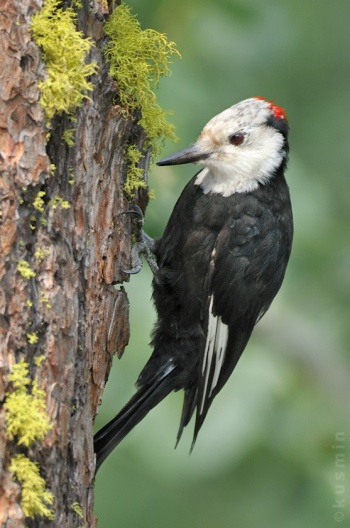- Dryobates albolarvatus
Identification
24 cm (9½ in)
- Black body
- White wing patches
- White head and throat
Male: has a red mark on back of his head
Variation
The two subspecies are supposedly weakly differentiated and differ mainly in length of bill.
Distribution
British Columbia south to the southern tip of California. Also in western Nevada and Idaho.
Taxonomy
Placed in genus Leuconotopicus by Gill and Donsker. Formerly in genus Picoides.
Subspecies
There are 2 subspecies[1]:
- D. a. albolarvatus:
- Montane coniferous forests of southern British Columbia to south-western US
- D. a. gravirostris:
- South West California (mountains of Los Angeles (San Gabriel Mts.) to San Diego region)
Habitat
Montane coniferous forests.
Behaviour
Breeding
They nest in dead trees; the eggs are incubated for 14 days and the young fledge after a further 26 days.
Diet
The diet includes insects, particularly ants, beetles and scale insects. They also eat pine seeds.
References
- Clements, J. F., T. S. Schulenberg, M. J. Iliff, D. Roberson, T. A. Fredericks, B. L. Sullivan, and C. L. Wood. 2016. The eBird/Clements checklist of birds of the world: v2016, with updates to August 2016. Downloaded from http://www.birds.cornell.edu/clementschecklist/download/
- Handbook of the Birds of the World Alive (retrieved October 2016)
- Birds of North America online retrieved June 2018
Recommended Citation
- BirdForum Opus contributors. (2025) White-headed Woodpecker. In: BirdForum, the forum for wild birds and birding. Retrieved 17 May 2025 from https://www.birdforum.net/opus/White-headed_Woodpecker
External Links
GSearch checked for 2020 platform.1





